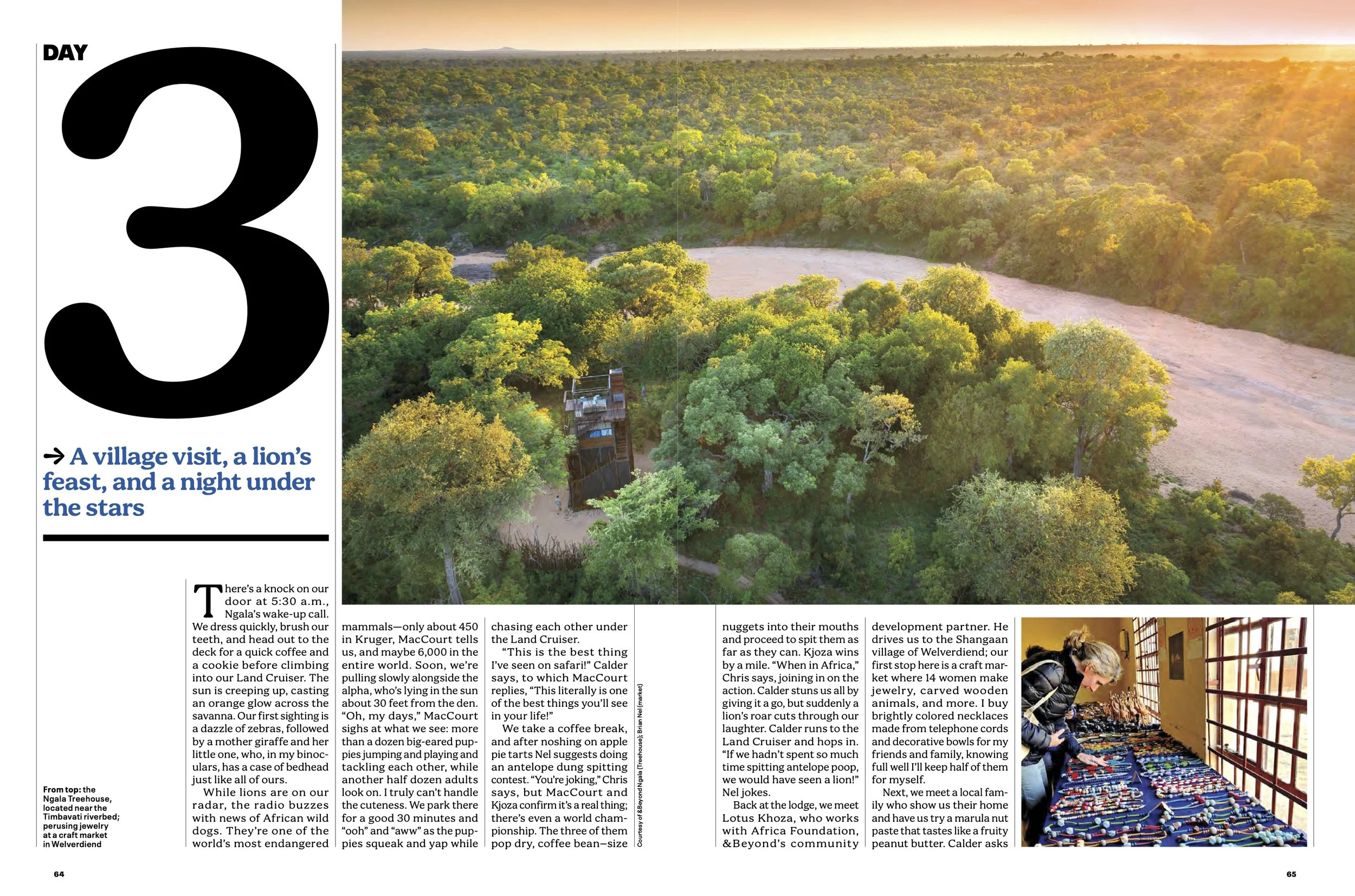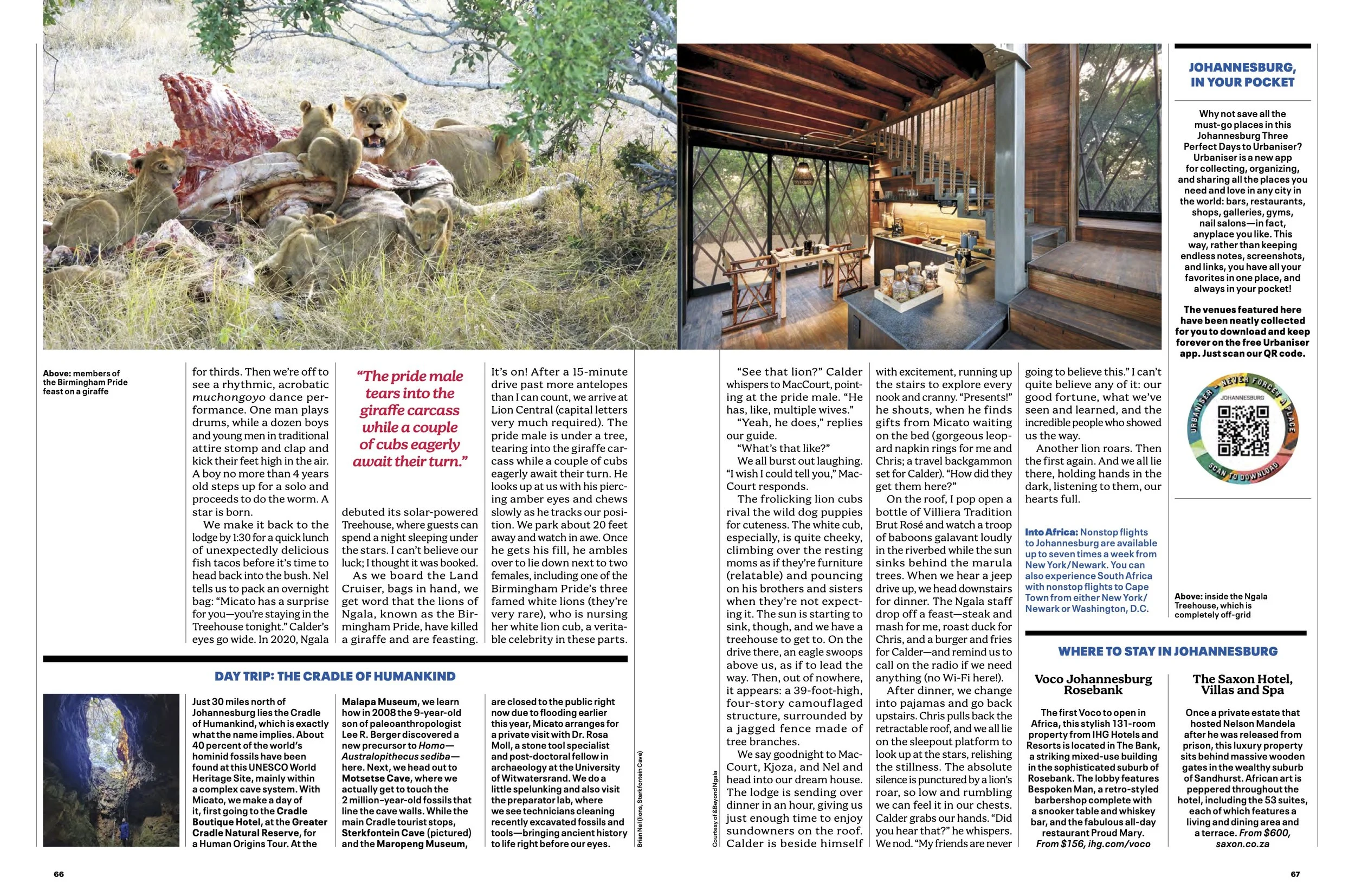Three Perfect Days Johannesburg
Hemispheres, October 2023
Johannesburg is a city of profound contrasts, palpably connected to humanity’s common past. Thirty-two years after the end of apartheid—the oppressive system that effectively froze the country in time—South Africa’s largest, richest city positively blazes with creativity and ambition, every corner testifying to the struggle for justice and freedom. In this way, “Joburg,” or “Jozi,” is a perfect entry point for rural Africa—a radiant, cosmopolitan gateway to the older, wilder life beyond the city’s borders. A 75-minute flight gets you to Kruger National Park, where you can gawk at every animal in the famed Big Five on safari, while a 30-mile drive brings you to the place to which we all trace our origins, the UNESCO World Heritage Site known as the Cradle of Humankind. Few major cities offer such a rich mix of metropolitan pleasures and natural thrills.
Day 1
A very personal history lesson, a street art tour, and a playful dinner in Johannesburg
Can you see Johannesburg, a city of 6 million people stretching across 600 square miles, in a single day? No, is the obvious answer, but I’ve warned my husband, Chris, and 10-year-old son, Calder, that we’re going to pack in as much as we possibly can before we head off to the bush tomorrow. Fortunately, Brian Nel, a safari director from Micato Safaris who will be our right-hand man/ jovial uncle/BFF for the next three days, is eager to fill every second of our first day in South Africa.
Though we all feel like VIPs at the Saxon Hotel, Villas and Spa, in the tony suburb of Sandton, we have some stiff competition; on the walls are portraits of past guests such as Oprah Winfrey, Bill Clinton, and, most famously, Nelson Mandela, who decamped here to finish his autobiography, Long Walk to Freedom, after being released from prison in 1990. Outside, some less-honored guests screech as we pile into our van. “What is that?” Calder asks, covering his ears. “It’s a hadada ibis,” Nel says, pointing at a long-billed gray bird. “We love them… barbecued for lunch.”
We’re starting our morning in Soweto, and on our 30-minute drive to the township, which was created in the 1930s when the government began separating Black residents from white ones, Nel offers up some Joburg history—a gold rush in 1886 established the city—along with a bit of his own. Now in his 50s, he was raised during apartheid, and as a white person was conscripted into police service to defend a regime built on hatred and discrimination. The end of apartheid brought an emotional reckoning that remade him as a person. Chris and I have both read plenty about apartheid, but we still find Nel’s personal story sobering.
Nel and Micato have arranged for a local Soweto guide to join us this morning. Alina Nkosi-Mlotshwa became the first Black guide in the township in 1987. “Soweto is a city within a city,” she says as we drive past tiny, red slate–roofed homes, makeshift tented barbershops, and goats for sale on the side of the road. “We have the lowest of the low class, the middle class, the millionaires.”
Our first stop is the Hector Pieterson Museum, which honors the more than 170 students killed in the 1976 Soweto Uprising, including the 12-year-old Pieterson. A photo of a young man carrying the mortally wounded child, his sister running alongside in agony, was published in international newspapers, awakening the world to the violence of apartheid. “I read that Hector Pieterson’s sister, Antoinette Sithole, sometimes gives talks at the museum,” I say. “We’ve arranged for you to meet her,” Nel replies, with a smile and a wink.
Sithole turns out to be a petite, stylish woman with close-cropped hair and an easy, peaceful smile. “I noticed in life, it doesn’t matter what comes your way,” she says. “You still have to be positive.” She details the organized, peaceful protest by students who sought classes in their own language, the sudden turn into violence, and how she processed the tragedy. “At first, I wouldn’t even look at the picture,” she says, standing mere feet from the giant image. “But one day, I said, ‘I need to find closure.’” Shortly after apartheid ended, she was asked to speak in front of the Truth and Reconciliation Commission. “After telling my story—two, three minutes—I felt changed. And I said to the panel, ‘You know what? I’ve forgiven all of those who did this.’”
Nel, eyes brimming, comes up to Sithole. “Thank you,” he says. “I don’t know how to say this, but I used to be in the police, and I wasn’t aware of the damage we were doing until I became exposed to what was happening. So on a personal note I would like to say I’m sorry. I learned too late. I only transformed because of these things.” Sithole takes his hand and holds it for a moment, nodding.
Deeply moved, we thank Sithole and take a short walk down Vilakazi Street—“the only street in the world home to two Nobel Prize winners, Nelson Mandela and Desmond Tutu,” Nkosi-Mlotshwa says—passing street performers and sidewalk vendors on the way to Mandela House. Now a museum, the two-room structure was where Mandela lived from 1946 until he was imprisoned in 1962. Our tour guide, a spunky woman named Precious, says that when he was released in 1990, he only stayed at the house for 11 days. “There was no security,” she says, “so he moved to Beverly Hills.” Calder nudges me: “She means our hotel, right?”
Next, we make our way to the Apartheid Museum. Taking in the exhibits and artifacts—a room full of 131 nooses symbolizing political prisoners who were executed by the government, pictures of Black classrooms without desks for students or teachers, a rock-dented armored car—I’m amazed that the museum opened just 10 years after apartheid ended.
We could stay for hours and not absorb everything, but the kid needs to eat, stat. We scoot off to the artsy suburb of Rosebank to lunch at Proud Mary, in the hip Voco hotel. Calder devours a giant burger, Chris goes for wood-fired chicken marinated in a spicy pele pele sauce, and I dig into a beef fillet served with a side—a side!—of oxtail shepherd’s pie.
Now, it’s time to walk off all those calories. Nel shepherds us to Maboneng, a creative hub in downtown Joburg, to meet with Kgothatso Lebelo, a guide with One Day Africa, for a street art tour. On these streets, art entwines with politics. There’s a series of Black freedom fighters, including South Africans Steve Biko and Chris Hani, and a depiction of King Goodwill Zwelithini, the late monarch of the Zulu nation. Even a two-story portrait of pop singer Simphiwe Dana by the artist Dbongz makes a statement. “She’s holding a golden egg,” Lebelo says. “It means women here have the golden touch.”
As the day’s golden light fades, so does my child. Nel suggests that Chris and I go to dinner while he stays at the hotel with Calder. “Little Lord Fauntleroy can order room service while I sit in the lobby and get some work done,” he says. I want to hug him.
Chris and I get spiffed up and head to Les Créatifs, an avant-garde restaurant from chef Wandile Mabaso. Raised in Soweto, he trained in France and worked at Michelin-starred restaurants in Paris and New York before coming back to Joburg to open his own place. We know we’re in for a fun dinner when our waiter brings the amuse-bouche: an egg shell on a bed of dried corn with a straw inserted into a small hole full of rich chicken broth. The beautifully plated dishes—a garam masala–spiced duck confit with a gastrique made from naartjie (a South African citrus fruit) is a standout—match the striking art on the wall by Joburg-based painter Sthu Manaka.
Back at the Saxon, we greet Nel in the lobby, and I do give him that hug—blame the wine—before heading to our room, where Calder has dispatched a plate of mac ’n’ cheese while playing Minecraft. We usher him off to bed with a promise that makes him grin ear to ear: “Tomorrow, we might see elephants!”
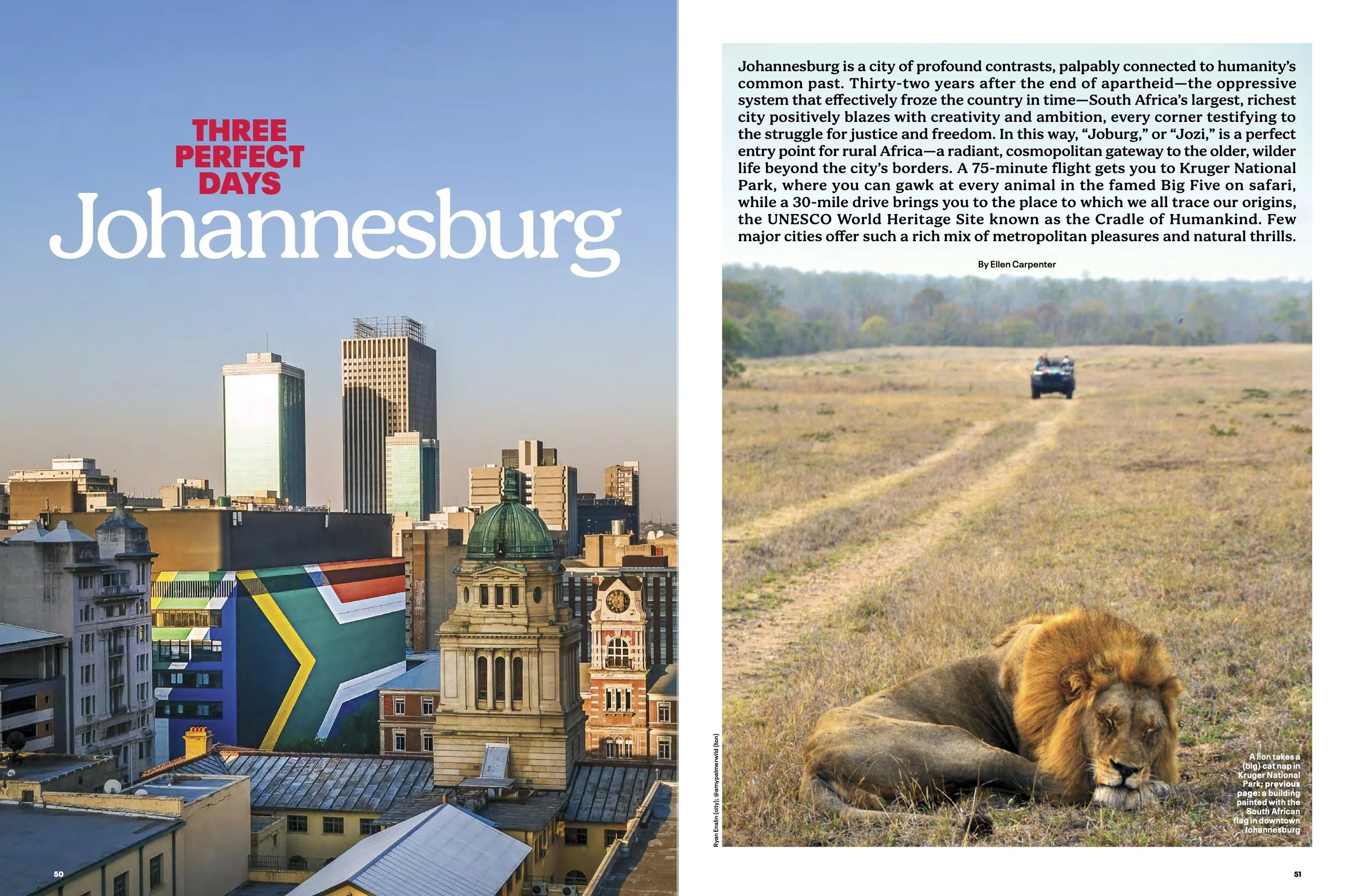
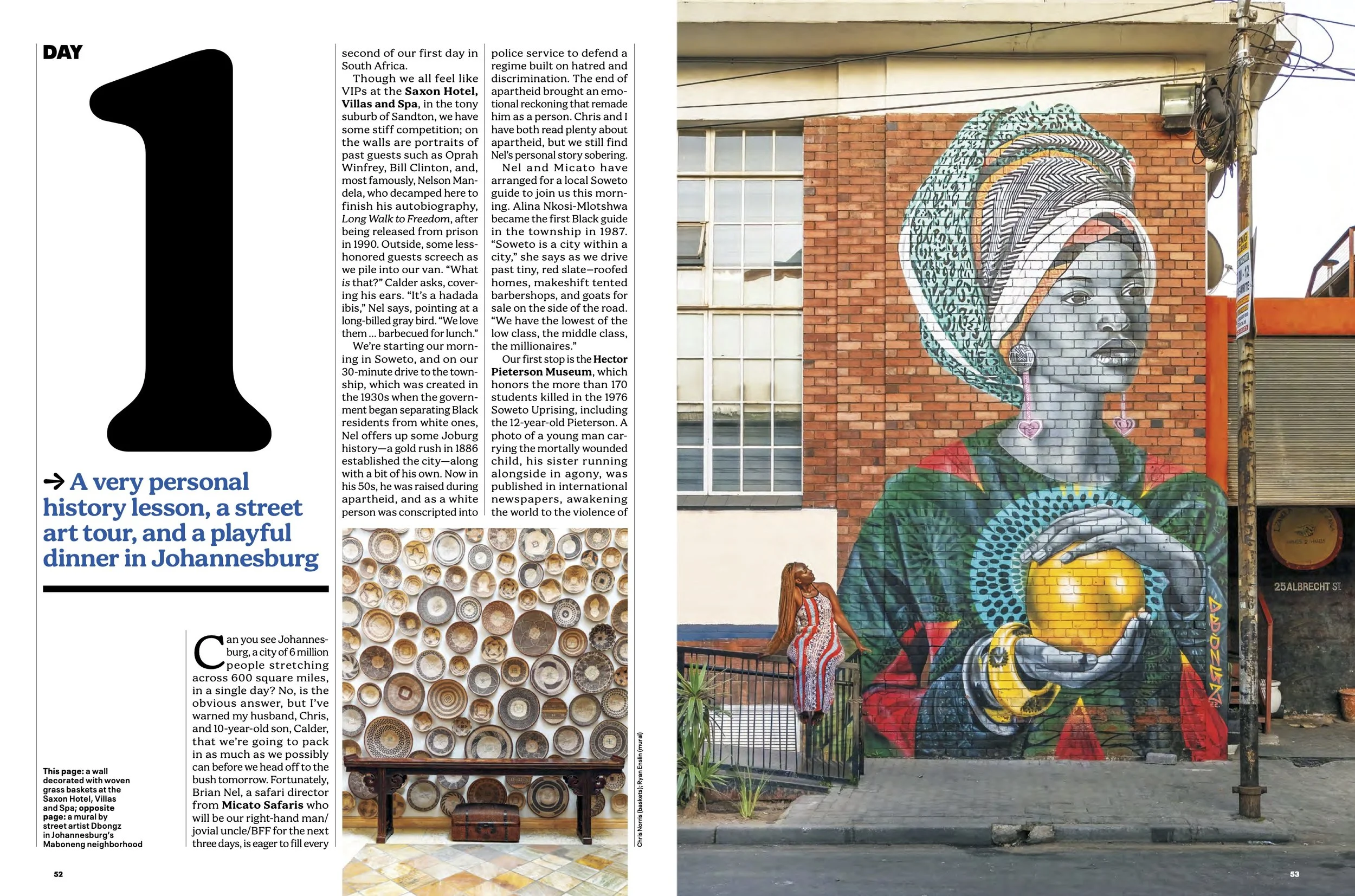
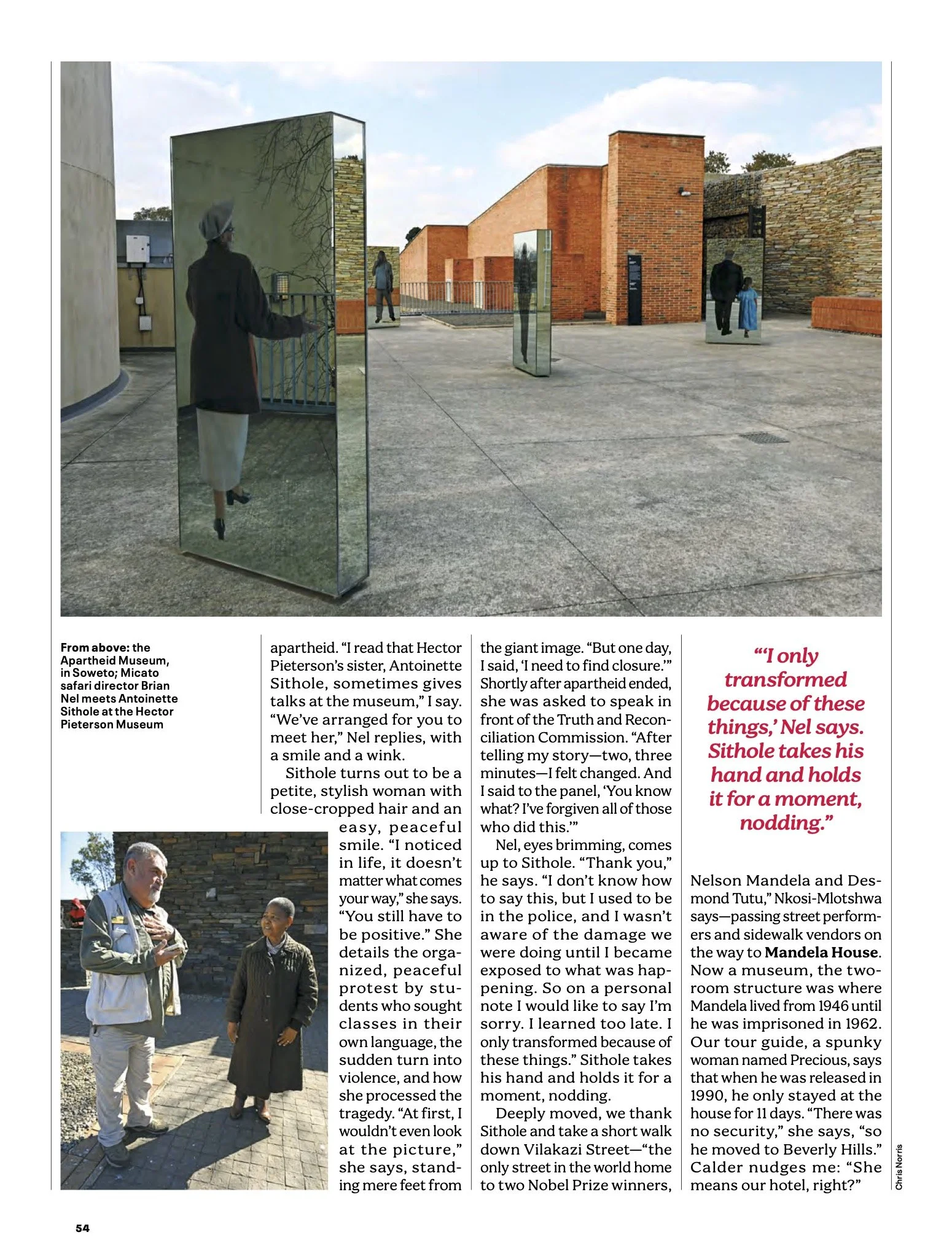
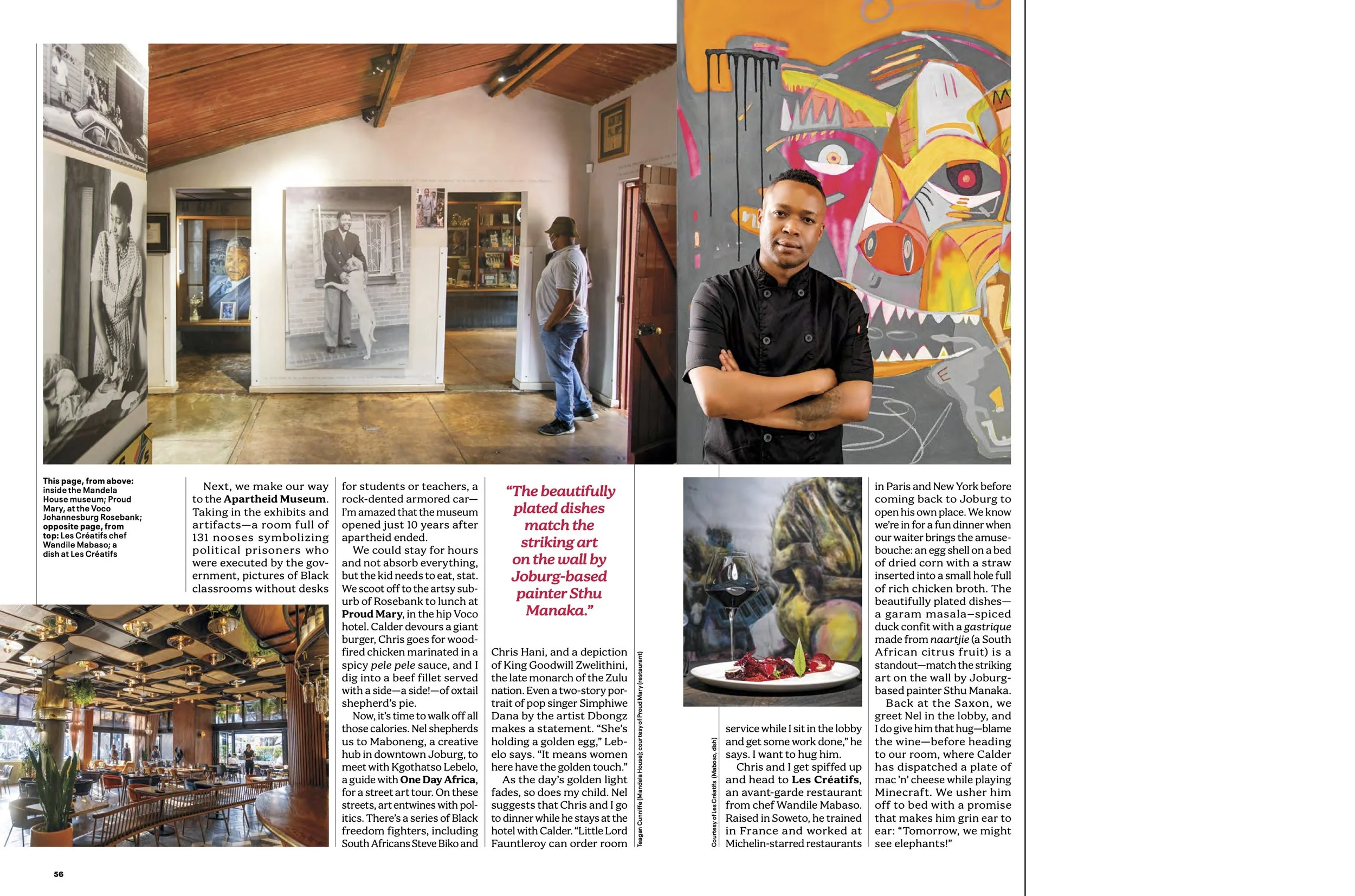
Day 2
Spotting zebras, giraffes, and elephants in Kruger National Park
After room service pancakes topped with berries and cream and a massive pot of coffee, we check out of the Saxon and meet Nel to head to the airport for our 75-minute flight to Kruger National Park. Calder can’t get over the fact that he gets to walk on the runway right up to our nine-seater prop plane. He films a YouTube-style video for his friends and then, as soon as we reach 21,000 feet, passes out.
Before I can post an Instagram story of our epic time in Joburg, we land at the private air strip for &Beyond Ngala Safari Lodge. We meet guide Liam Robert “Mac” MacCourt and tracker Siyabonga “Siya” Khoza, who whisk us off in an open-top, hunter-green Land Cruiser to the lodge. We’re spoiled to have two adjoining rooms, but Calder balks at sleeping alone: “Oh no. There are leopards out there!”
We’re eager to see some animals, but lunch and orientation come first. In the courtyard, Chris, Nel, and I munch on fish and chips made from kingklip, a South African cusk eel, and Calder opts for spinach and ricotta gnocchi. Our genial waiter, Norman, who has worked here for 20 years, teaches us how to say “avuxeni,” which means “good day” in Shangaan, the main language spoken in this area. Ngala, we learn, is the Shangaan word for lion.
At orientation, MacCourt lays out a map of Africa and points out where we are, noting that Ngala is a 37,000-acre privatized game reserve within Greater Kruger National Park’s 4.9 million acres. The Timbavati riverbed, which we’ll be exploring, is “almost like a cliché image of Africa,” he says—which sounds perfect to me. “OK, what animals do you want to see?” MacCourt asks, bright green eyes searching. Calder bursts out: “Lions, elephants, zebras, cheetahs, giraffes…” “All right,” MacCourt says with a laugh. “Let’s go.”
Calder wants to sit in the spotter’s chair in the Land Cruiser’s bow, but no dice. “That’s Siya’s spot, so he can look for tracks,” MacCourt tells him. “Siya, you’ve got the perfect name for this job,” Chris says, then shakes his head and adds, “I just said the joke you hear every single day.” Khoza shrugs, nods, and laughs. His dad, it turns out, is the head ranger at &Beyond Ngala and encouraged him to pursue a different career, to no avail. “I used to come visit him, and he’d take us on game drives,” he says. “When I saw these people go out and track the lions, I knew I wanted to do this.”
We hit the road, and MacCourt lays out the plan: “OK, every game drive we go on is going to have a focal animal we’re going to find,” he says. “Lions!” I shout, before stifling a squeal of excitement. “But those plans can change pretty quickly,” he continues, giving me a knowing look. (In other words, don’t get my hopes up.) Two minutes in, we spot our first animal, a lone wildebeest, and I can’t help but think of poor Mufasa. (Yes, all my knowledge about Africa comes from The Lion King.)
After this, animals appear surprisingly quickly: two kudu showing off white tails as they run (“Spotting kudu is a good sign, because lions eat them,” MacCourt notes), a cartoonish Southern yellow-billed hornbill, a slew of nervous-looking impalas hanging out with a single warthog, and a couple of mohawked zebras coquettishly hiding behind some bushes. We slowly approach a prone hyena, who eyes us suspiciously.
“He looks so cute,” Calder whispers. “Until he tears your face off,” MacCourt says. The hyena rises, showcasing its prehistoric, hunchbacked body, and trots away. “OK, it looks a lot scarier when it stands up,” Calder admits, scooting toward the middle seat.
Soon we stop again to take pictures of three long, languorous giraffes nibbling mopani leaves. “I’m not going to, but if I jumped out real fast, could I run and touch a giraffe?” Calder asks. As if weighing this, MacCourt says, “No, I don’t think you could.” Calder insists, “I could sprint.”
Instead, we stop for a cocktail, or, in safari-ese, a sundowner. We park in the dry Timbavati riverbed, and, in what seems like mere seconds, MacCourt and Khoza set up a pop-up bar, complete with tablecloth. My glass of Amarula, a South African cream liqueur made from the fruit of the marula tree, goes down as easy as the sinking orange sun.
With night coming fast, we jump back in the Land Cruiser. MacCourt steers over bumpy roads, while Khoza sweeps his giant spotlight left to right through the dark. Abruptly, a herd of elephants appears right beside our path. I’m surprised to feel fear, rather than excitement. I love elephants, but seeing their massive forms materialize in the dark drives home how wild and dangerous they truly are. We stop to wait as they unhurriedly cross the dirt road. We look up at the brilliant stars filling the night sky, and Nel points out Libra—Chris’s and my star sign—and the Southern Cross. A satellite passes, and, finally, the elephants do too.
Dinner, back at the lodge, is a buffet-like barbecue with all the fixings. The highlight is pap, South Africa’s version of polenta, topped with an onion and tomato gravy. MacCourt joins us for the meal and shares what led him to become a guide, after he’d earned a degree in electrical engineering. “Animals,” he says, then laughs. “I love them, and I love watching other people appreciate animals.”
MacCourt started working at &Beyond two years ago, at age 23, and matured swiftly. “You very quickly realize you’ve got to grow up,” he says, “because these people are your responsibility.” During COVID, he explains, so many people watched live streams and anthropomorphized the animals here that he now finds he has to keep reminding them what animals are like IRL. “I found it surprisingly challenging to get this message across that these are wild animals. It can feel misleading when you’re sitting next to a lion and he’s sleeping, but things can change very quickly, and that’s where my job becomes important.”
These words put a little fear in me, but not enough to stop me from wanting to see the kings of Kruger up close. “Tomorrow,” I tell MacCourt before heading off to bed, “lions.”
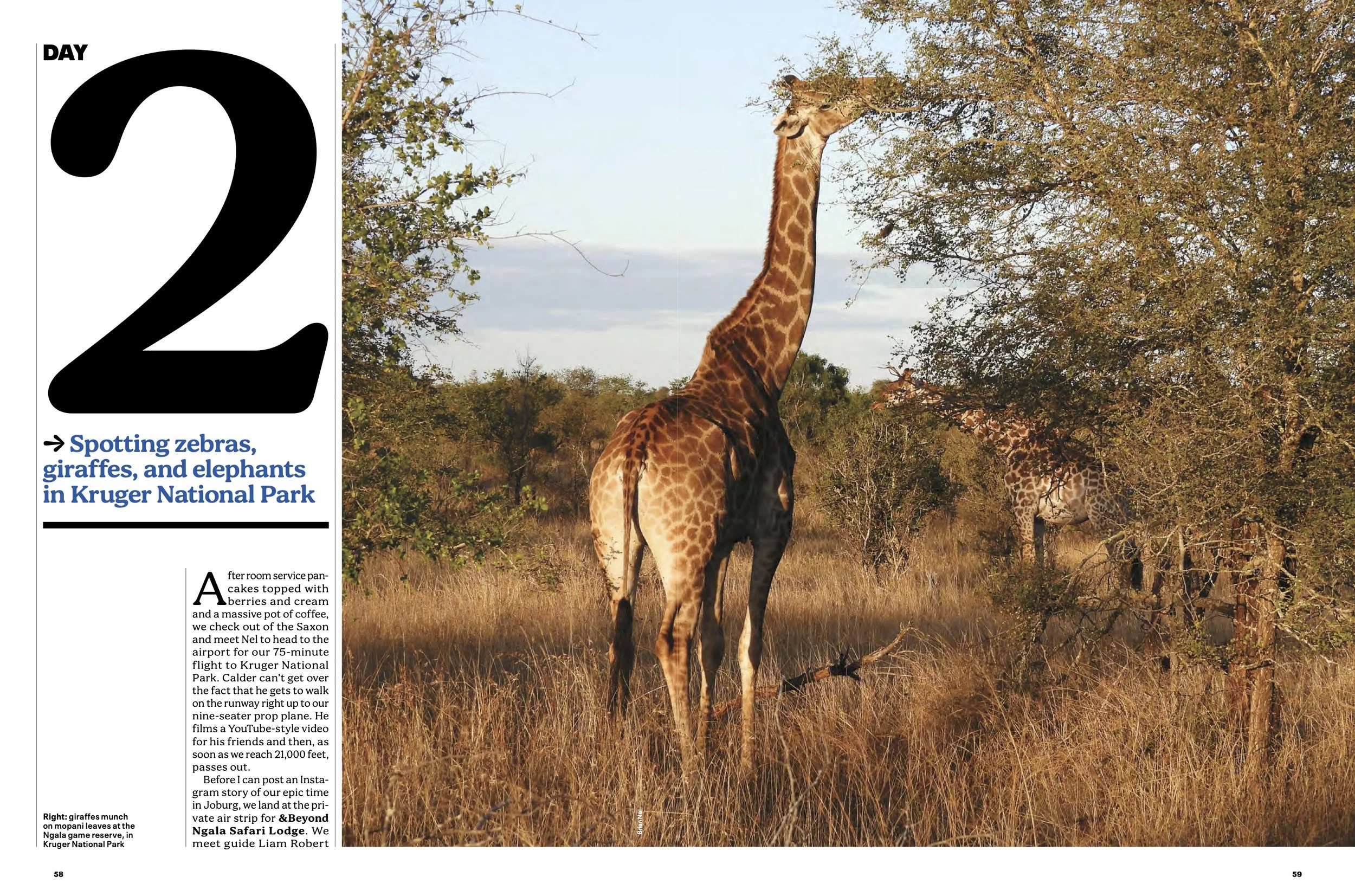
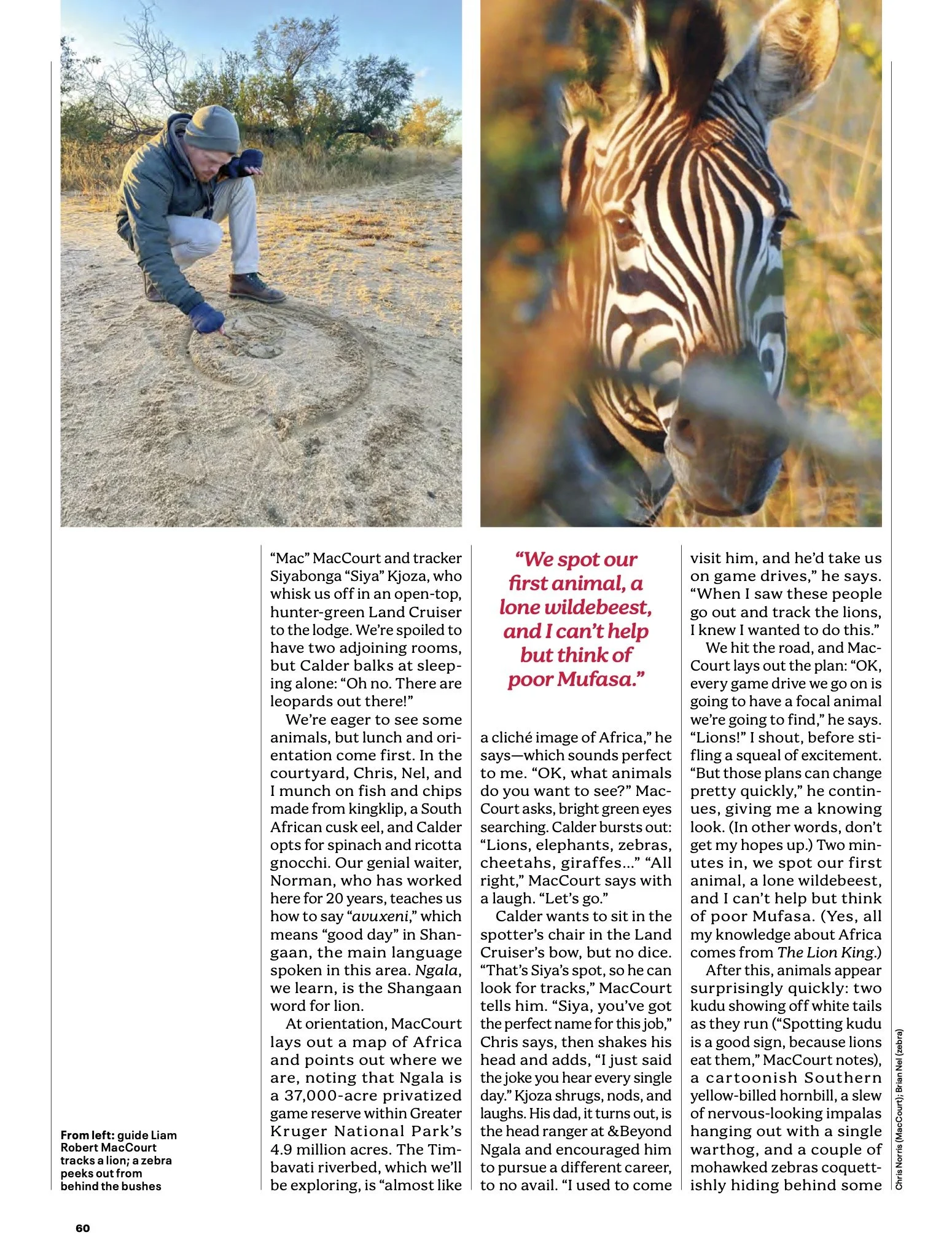
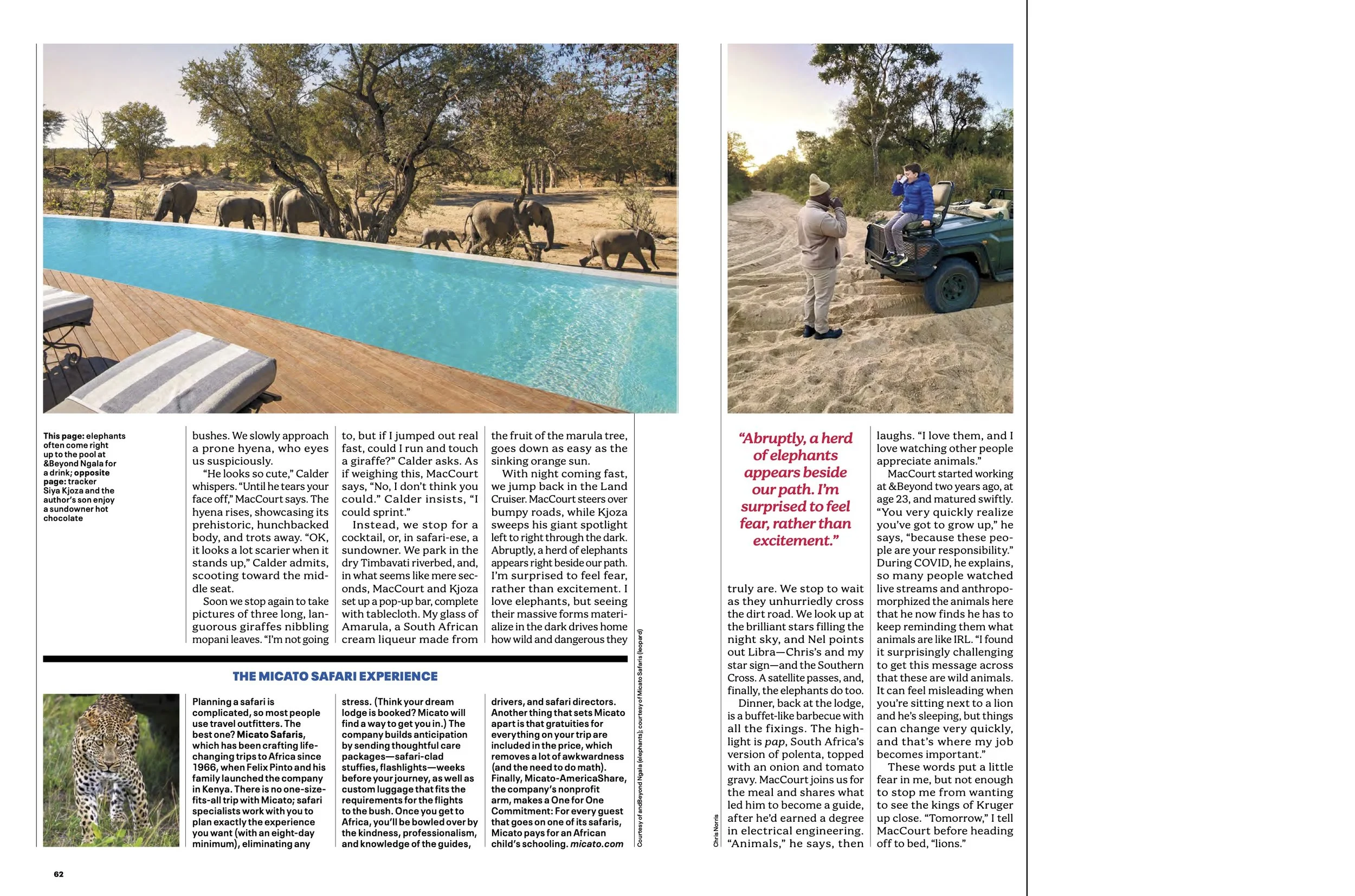
Day 3
A village visit, a lion’s feast, and a night under the stars
There’s a knock on our door at 5:30 a.m., Ngala’s wake-up call. We dress quickly, brush our teeth, and head out to the deck for a quick coffee and a cookie before climbing into our Land Cruiser. The sun is creeping up, casting an orange glow across the savanna. Our first sighting is a dazzle of zebras, followed by a mother giraffe and her little one, who, in my binoculars, has a case of bedhead just like all of ours.
While lions are on our radar, the radio buzzes with news of African wild dogs. They’re one of the world’s most endangered mammals—only about 450 in Kruger, MacCourt tells us, and maybe 6,000 in the entire world. Soon, we’re pulling slowly alongside the alpha, who’s lying in the sun about 30 feet from the den. “Oh, my days,” MacCourt sighs at what we see: more than a dozen big-eared puppies jumping and playing and tackling each other, while another half dozen adults look on. I truly can’t handle the cuteness. We park there for a good 30 minutes and “ooh” and “aww” as the puppies squeak and yap while chasing each other under the Land Cruiser.
“This is the best thing I’ve seen on safari!” Calder says, to which MacCourt replies, “This literally is one of the best things you’ll see in your life!”
We take a coffee break, and after noshing on apple pie tarts Nel suggests doing an antelope dung spitting contest. “You’re joking,” Chris says, but MacCourt and Khoza confirm it’s a real thing; there’s even a world championship. The three of them pop dry, coffee bean–size nuggets into their mouths and proceed to spit them as far as they can. Khoza wins by a mile. “When in Africa,” Chris says, joining in on the action. Calder stuns us all by giving it a go, but suddenly a lion’s roar cuts through our laughter. Calder runs to the Land Cruiser and hops in. “If we hadn’t spent so much time spitting antelope poop, we would have seen a lion!” Nel jokes.
Back at the lodge, we meet Lotus Khoza, who works with Africa Foundation, &Beyond’s community development partner. He drives us to the Shangaan village of Welverdiend; our first stop here is a craft market where 14 women make jewelry, carved wooden animals, and more. I buy brightly colored necklaces made from telephone cords and decorative bowls for my friends and family, knowing full well I’ll keep half of them for myself.
Next, we meet a local family who show us their home and have us try a marula nut paste that tastes like a fruity peanut butter. Calder asks for thirds. Then we’re off to see a rhythmic, acrobatic muchongoyo dance performance. One man plays drums, while a dozen boys and young men in traditional attire stomp and clap and kick their feet high in the air. A boy no more than 4 years old steps up for a solo and proceeds to do the worm. A star is born.
We make it back to the lodge by 1:30 for a quick lunch of unexpectedly delicious fish tacos before it’s time to head back into the bush. Nel tells us to pack an overnight bag: “Micato has a surprise for you—you’re staying in the Treehouse tonight.” Calder’s eyes go wide. In 2020, Ngala debuted its solar-powered Treehouse, where guests can spend a night sleeping under the stars. I can’t believe our luck; I thought it was booked.
As we board the Land Cruiser, bags in hand, we get word that the lions of Ngala, known as the Birmingham Pride, have killed a giraffe and are feasting. It’s on! After a 15-minute drive past more antelopes than I can count, we arrive at Lion Central (capital letters very much required). The pride male is under a tree, tearing into the giraffe carcass while a couple of cubs eagerly await their turn. He looks up at us with his piercing amber eyes and chews slowly as he tracks our position. We park about 20 feet away and watch in awe. Once he gets his fill, he ambles over to lie down next to two females, including one of the Birmingham Pride’s three famed white lions (they’re very rare), who is nursing her white lion cub, a veritable celebrity in these parts.
“See that lion?” Calder whispers to MacCourt, pointing at the pride male. “He has, like, multiple wives.”
“Yeah, he does,” replies our guide.
“What’s that like?”
We all burst out laughing. “I wish I could tell you,” MacCourt responds.
The frolicking lion cubs rival the wild dog puppies for cuteness. The white cub, especially, is quite cheeky, climbing over the resting moms as if they’re furniture (relatable) and pouncing on his brothers and sisters when they’re not expecting it. The sun is starting to sink, though, and we have a treehouse to get to. On the drive there, an eagle swoops above us, as if to lead the way. Then, out of nowhere, it appears: a 39-foot-high, four-story camouflaged structure, surrounded by a jagged fence made of tree branches.
We say goodnight to MacCourt, Khoza, and Nel and head into our dream house. The lodge is sending over dinner in an hour, giving us just enough time to enjoy sundowners on the roof. Calder is beside himself with excitement, running up the stairs to explore every nook and cranny. “Presents!” he shouts, when he finds gifts from Micato waiting on the bed (gorgeous leopard napkin rings for me and Chris; a travel backgammon set for Calder). “How did they get them here?”
On the roof, I pop open a bottle of Villiera Tradition Brut Rosé and watch a troop of baboons galavant loudly in the riverbed while the sun sinks behind the marula trees. When we hear a jeep drive up, we head downstairs for dinner. The Ngala staff drop off a feast—steak and mash for me, roast duck for Chris, and a burger and fries for Calder—and remind us to call on the radio if we need anything (no Wi-Fi here!).
After dinner, we change into pajamas and go back upstairs. Chris pulls back the retractable roof, and we all lie on the sleepout platform to look up at the stars, relishing the stillness. The absolute silence is punctured by a lion’s roar, so low and rumbling we can feel it in our chests. Calder grabs our hands. “Did you hear that?” he whispers. We nod. “My friends are never going to believe this.” I can’t quite believe any of it: our good fortune, what we’ve seen and learned, and the incredible people who showed us the way.
Another lion roars. Then the first again. And we all lie there, holding hands in the dark, listening to them, our hearts full.
